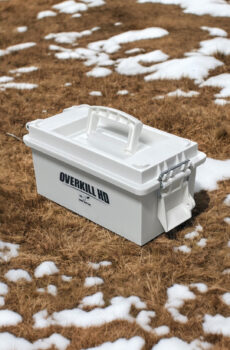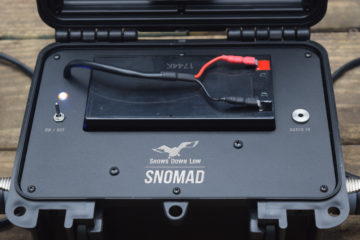Knowing how and when to use volume adjustments can lead to more opportunity
Using volume to persuade waterfowl towards your decoy spread is not a new tactic. Duck and goose hunters use their calls throughout fall and winter to hail call, softly finish, or hit waterfowl with a comeback call, each note having a specific emphasis and volume for a specific purpose of realism and persuasion. Just because we’re using an electronic call does not mean we sit back and let the machine do all the talking. We can use volume adjustments to our advantage to finish birds closer, persuade unwilling snow geese into our spread, and make them do things we want them to by getting their attention and hitting the right calls at the right time.
Ask any experienced snow goose hunter about the volume settings of their e-caller and you’ll probably get a variety of different answers. However, a common piece of advice you’ll likely hear is how important it is to have the volume of your e-caller “just right” so birds finish – that is, not too loud and not too quiet, “just right”. While that’s definitely solid advice, there are situations that call for adjusting the volume of your e-caller during the hunt. In this article, we’ll discuss why volume – and the ability to adjust volume – is an important tactic to master to help improve your snow goose hunting success.
Finding that “Just Right”
Finding that perfect volume level of your electronic call to decoy snow geese is a very specific setting for a given day. Weather can greatly affect that “sweet spot” of the call. For example, on a windy day, you may need to turn the volume up higher than usual, and on a foggy day you might turn the volume down a bit lower than usual. Your spread size, location within the flyway, and the birds will also influence where you need to set your e-caller volume. As a general rule when you have the caller running and have birds working the decoys, try to find a volume level loud enough to make your spread sound real, but not so loud that you can’t hear the birds working the spread. It’s important to listen to the birds because they have their own language when working the spread, and you’ll begin to learn what their sounds mean – both good and bad. Run the caller too loud and you’ll most definitely blow them out [flare the birds].
As a general rule when you have the caller running and have birds working the decoys, try to find a volume level loud enough to make your spread sound real, but not so loud that you can’t hear the birds working the blocks.
When to Turn it Down
Lower volume levels are useful when running multiple callers throughout your spread as they provide an accurate and realistic flock sound, especially if you’re running different or offset tracks on each call. Set your volume level close to what you would expect to hear from a natural flock, or slightly louder if it’s a windy day.
Some hunters like to leave a call running all day at a lower volume level to provide some sound for those sneaky singles and small groups that seem to find you without you knowing they are there. Turning a caller on when birds are already working is a good way to get back to your nap without firing a shot, as the sudden sound coming from the decoys will usually result in the working birds thinking something isn’t right. The birds will usually lift, maybe give you another pass or two, and leave.
Turning a caller on when birds are already working is a good way to get back to your nap without firing a shot… sudden sound will usually result in the birds thinking something isn’t right…
When to Crank it UP!
At this point, you might be thinking: “If quiet and lower volume sounds are what finish birds, what good are loud e-callers?”. The answers are “Reach” and “Persuasion”. Having the ability to crank up your caller to get super loud is a useful tool, similar to having some real power under the hood of your truck — you don’t always use it but it’s sure nice to have it available if, or more likely when you need it. Let’s explore why volume is nice to have, and when you might use it.
Reach. There are a few ways to attract snow geese to your spread. Visibility is arguably most important and we achieve this with the location and size of the spread. Motion is definitely important and we achieve this with flagging, motion devices such as rotary machines, and decoy movement. So where do sound and volume fit in? I can tell you from experience there are scenarios hunting migrators and we see birds flanking us in the distance, we hit them with extreme volume (130dB+) and sharp, clear sound from the e-caller turned to 100% volume, and you’ll see those distant birds hit the brakes, ball up, and turn to come straight at you. Something made them look our way, then they see the spread, and here they come. What made that happen? Coincidences aside, it’s happened more often than not that the geese turn to you when they’re hit with that loud, clear sound. The point is, you can reach distant birds with volume and turn them to you, but you can’t do that if your call doesn’t have the power under the hood or the quality speakers and components to reach those effective volume levels and maintain audio quality and clarity. If somebody is telling you that volume doesn’t matter, just move on – they probably don’t believe in tossing out a hail call on distant mallards, either… But history, experience, and successful hunts prove otherwise that hail calls are effective in certain situations.
Snow geese are greedy, so when you can pique their curiosity they’ll come back – often times with a stronger commitment.
Persuasion. Another tactic we use e-caller volume for is to hit snow geese with a “comeback call”. If you hunt snow geese long enough you will have birds overly work the spread, never getting any lower than 100 yards, and never wanting to commit. Everything can be perfect with the spread and your hide but sometimes pressured birds just don’t want to decoy. Eventually, they slide off and start flying away. What can you do? At this point you have nothing to lose, so try hitting them with some higher volume. I have witnessed birds slide off and we’ll let them get to 2-300 yards, then “roar” the flock (our flock, i.e. the decoys) with the e-caller cranked up to 100%. Watch the birds carefully, because a lot of the time they will turn around and come back with a little more interest than they had before. We’ve successfully harvested birds using this tactic from flocks that initially were minimally interested, then after getting hit with a comeback call ended up committing and decoying with reckless abandon. Snow geese are greedy, so when you can pique their curiosity they’ll come back – oftentimes with a stronger commitment. It’s rewarding to pull up on those flocks knowing you got a second chance because you manipulated the snow geese into your spread by calling when they had no intention of giving you a look.
Summary
There will be days the snow geese always win, but knowing how and when to use the volume adjustment of your electronic call – and having the capability for higher volume – will give you more tactics to tilt those odds a little more in your favor.
Related Products
-
Electronic Calls (E-Callers)Overkill Series Calls
OVERKILL HD Electronic Snow Goose Call
The Snows Down Low OVERKILL HD E-Caller offers some of the best features available of any electronic snow goose call on the market today, all at a great value. The OVERKILL HD leaves no detail overlooked. We considered everything when designing this e-caller and built it to be a reliable performer.
Please allow 1-2 weeks for production and delivery. (updated Feb. …

